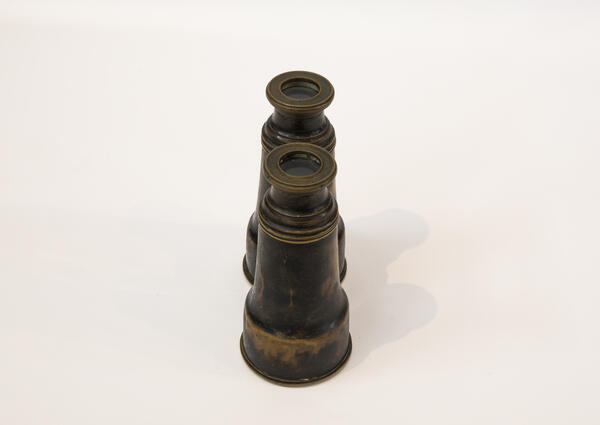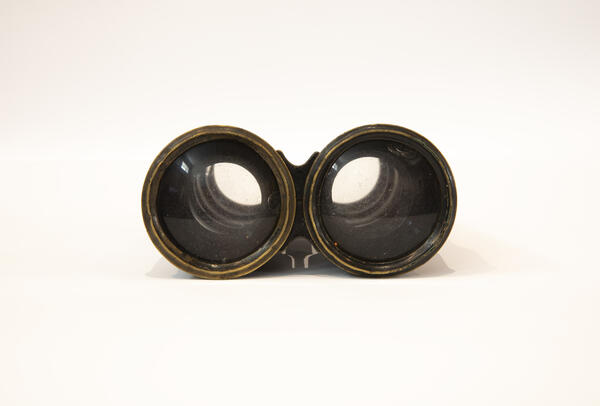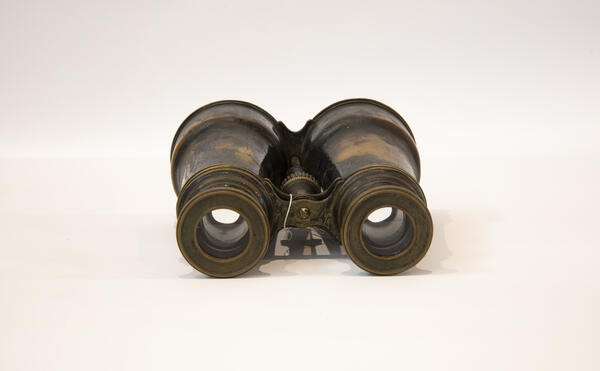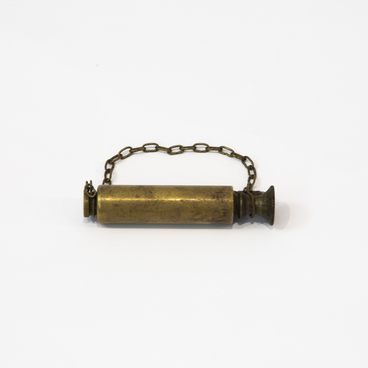This pair of binoculars consists of two monocular telescopes packed together and a grooved focusing wheel. The device is made of metal and painted black. It was produced in the early 20th century. Such binoculars, also known as field glasses, were often used on the battlefield during World War I. “From under a stunted crab-apple tree, Grigory watched the distant enemy through his field glasses” (Mikhail Sholokhov, “And Quiet Flows the Don”, Book 3, Chapter 8).
The history of binoculars can be traced back to the 17th-century Netherlands where the first optical instruments known as telescopes were invented for the purposes of mariners. With a telescope, it was possible to observe objects far away from the viewer but having to use only one eye was uncomfortable.
In 1609, the Italian Galileo Galilei invented an optical instrument with two lenses — a convergent one and a divergent one. This was the first design to provide binocular vision. The name “telescope” originated from the Latin words for “two eyes”. The Galilean design provided a low magnification.
By conducting further experiments, Galileo was able to create more powerful telescopes which magnified objects up to 33 times. This design combined two lenses, one of which focused light beams to form an image while the other one dispersed the beams. The Galilean design was simple and provided a sharp image (up to a certain magnification level). However, such binoculars had a narrow field of view and could not be used as a measuring instrument.
Galileo’s design was improved by the German mathematician Johannes Kepler who invented special prisms only a year later. Prism binoculars allowed users to measure distance. This device also offered a wider field of view. However, the new design also had a drawback: it could only produce an inverted image.
In the early 19th century, opticians from France, Germany, and Russia created their own designs almost at the same time. Their binoculars had a more complex system of prisms which helped to erect an inverted image. This was the last stage in the development of modern binoculars. This design has been used to this day without any significant changes.
The history of binoculars can be traced back to the 17th-century Netherlands where the first optical instruments known as telescopes were invented for the purposes of mariners. With a telescope, it was possible to observe objects far away from the viewer but having to use only one eye was uncomfortable.
In 1609, the Italian Galileo Galilei invented an optical instrument with two lenses — a convergent one and a divergent one. This was the first design to provide binocular vision. The name “telescope” originated from the Latin words for “two eyes”. The Galilean design provided a low magnification.
By conducting further experiments, Galileo was able to create more powerful telescopes which magnified objects up to 33 times. This design combined two lenses, one of which focused light beams to form an image while the other one dispersed the beams. The Galilean design was simple and provided a sharp image (up to a certain magnification level). However, such binoculars had a narrow field of view and could not be used as a measuring instrument.
Galileo’s design was improved by the German mathematician Johannes Kepler who invented special prisms only a year later. Prism binoculars allowed users to measure distance. This device also offered a wider field of view. However, the new design also had a drawback: it could only produce an inverted image.
In the early 19th century, opticians from France, Germany, and Russia created their own designs almost at the same time. Their binoculars had a more complex system of prisms which helped to erect an inverted image. This was the last stage in the development of modern binoculars. This design has been used to this day without any significant changes.






